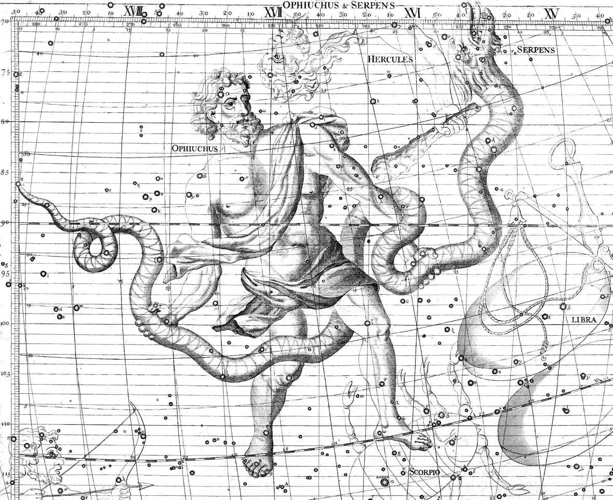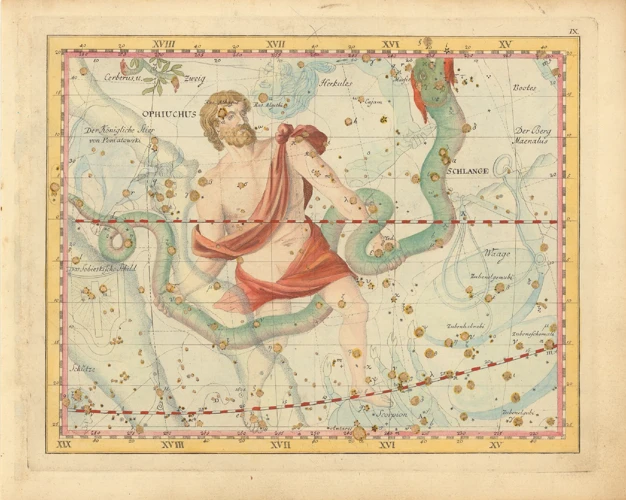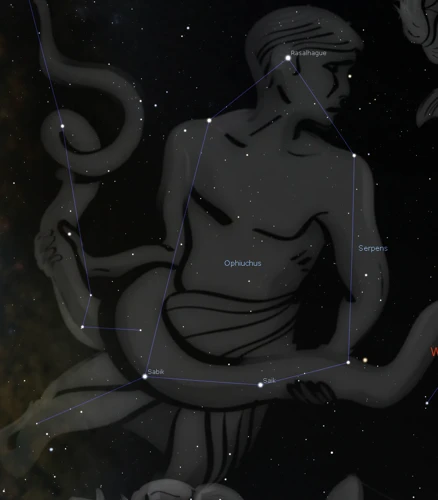The enigmatic nature of Ophiuchus, its rich symbolism and the scarcity of artistic depictions have long captured the curiosity of art and literature enthusiasts. This lesser-known zodiac constellation, also known as the Serpent Bearer, lies just beyond the traditional twelve zodiac signs. Hidden in the intricacies of ancient Greek pottery, medieval manuscripts, Renaissance paintings, and contemporary artworks, Ophiuchus seems to veil itself in mystery. Its presence in ancient mythology, classic literature, and modern fiction adds to its allure. In this article, we will delve into the rare depictions of Ophiuchus in art and literature, uncovering the hidden gems that shed light on this elusive constellation. Get ready to explore the intriguing world of Ophiuchus, as we unravel its secrets through the lens of artistic masterpieces and captivating narratives.
Contents
- The Ophiuchus Enigma
- The Symbolism of Ophiuchus
- Rare Artistic Representations
- Ophiuchus in Literature
- Conclusion
-
Frequently Asked Questions
- 1. Is Ophiuchus a recognized zodiac sign?
- 2. What is the symbolism of Ophiuchus?
- 3. How rare are artistic depictions of Ophiuchus?
- 4. Can Ophiuchus symbolize different traits and characteristics?
- 5. Are there any famous artworks featuring Ophiuchus?
- 6. How does Ophiuchus connect with other zodiac signs?
- 7. What role does Ophiuchus play in ancient mythology?
- 8. Are there any Ophiuchus-themed literary works?
- 9. How can Ophiuchus be integrated into modern astrology?
- 10. Is there a deeper historical significance to Ophiuchus?
- References
-
Frequently Asked Questions
- 1. What is Ophiuchus and why is it considered rare in art and literature?
- 2. Are there any hidden meanings behind the symbolism of Ophiuchus?
- 3. What are some examples of rare artistic representations of Ophiuchus?
- 4. How did ancient Greek pottery depict Ophiuchus?
- 5. What can we find in medieval manuscripts related to Ophiuchus?
- 6. Which famous Renaissance paintings include depictions of Ophiuchus?
- 7. How is Ophiuchus represented in contemporary artworks?
- 8. What is the significance of Ophiuchus in ancient mythology?
- 9. Can you provide examples of Ophiuchus in classic literature?
- 10. How is Ophiuchus portrayed in modern fiction?
- References
- Read More
The Ophiuchus Enigma

The Ophiuchus Enigma revolves around the intriguing aspects of this lesser-known zodiac constellation. What makes Ophiuchus truly perplexing is its position just beyond the traditional twelve zodiac signs. While the twelve signs are widely recognized and studied, Ophiuchus often remains a mystery to many. This enigmatic constellation challenges the traditional boundaries of astrology and prompts us to question its significance in our lives. Its rarity and association with the Serpent Bearer add to the mystique surrounding Ophiuchus. The symbolism and characteristics attributed to Ophiuchus further deepen the enigma, as they differ from those traditionally associated with the other zodiac signs. Exploring the cultural significance of Ophiuchus throughout history allows us to gain a better understanding of its place in astrology. Additionally, delving into the magnetic connection between Ophiuchus and other zodiac signs, such as Capricorn and Cancer, unveils potential insights into compatibility and relationships. Understanding the Ophiuchus enigma requires us to explore its various facets, from its historical significance to its unique traits and connections within the zodiac system. (Insert internal link: Exploring Cultural Significance of Ophiuchus in History)
The Symbolism of Ophiuchus

The Symbolism of Ophiuchus holds a unique place within the realm of astrology and mythology. Ophiuchus is often associated with the Serpent Bearer, a figure from ancient Greek mythology. This symbolizes the ability to handle and control powerful forces, representing healing and transformation. The serpent itself is a timeless symbol of wisdom, rebirth, and knowledge. In Ophiuchus, the serpent intertwines with the figure, symbolizing the harmony between the human and animalistic aspects of our nature. This signifies the potential for spiritual growth and the pursuit of higher consciousness. The symbolism of Ophiuchus also highlights its association with the medical profession and healing arts. The constellation’s connection to the staff of Asclepius, the Greek god of healing, further emphasizes its healing qualities. Ophiuchus embodies the desire to alleviate suffering and promote wellbeing. Additionally, when exploring compatibility within the zodiac, Capricorn and Taurus exhibit intriguing connections with Ophiuchus. The earthy nature of Capricorn aligns with the grounded and practical traits of Ophiuchus, enhancing compatibility and understanding. (Insert internal link: Compatibility of Capricorn and Taurus) The magnetic connection between Ophiuchus and Cancer suggests a deep emotional and intuitive bond that can foster harmonious relationships. (Insert internal link: Unveiling the Magnetic Connection between Capricorn and Cancer in Zodiac Compatibility) The symbolism of Ophiuchus encompasses a wide range of meanings, from wisdom and healing to spiritual growth and compatibility within the zodiac system.
Rare Artistic Representations

Ancient Greek pottery, medieval manuscripts, Renaissance paintings, and contemporary artworks provide us with rare and captivating glimpses into the artistic representations of Ophiuchus. These depictions are scarce but hold great significance in understanding the cultural and artistic perceptions of this elusive constellation. In ancient Greek pottery, Ophiuchus is often portrayed as a figure holding a snake, symbolizing the Serpent Bearer. These elegant and intricate designs carry mythological narratives and reveal the reverence bestowed upon Ophiuchus in ancient times. Moving into the medieval period, manuscripts feature elaborate illustrations that depict Ophiuchus alongside the other zodiac signs, showcasing the celestial hierarchy. Renaissance paintings showcase Ophiuchus in various forms, blending astrological symbolism with artistic mastery. Contemporary artworks explore Ophiuchus in a more modern context, often seeking to reinterpret and reimagine its place in the zodiac system. These rare artistic representations of Ophiuchus offer us a visual journey through time, showcasing the evolving interpretations of this mysterious constellation.
1. Ancient Greek Pottery
Ancient Greek pottery provides us with fascinating glimpses into the depiction of Ophiuchus. While Ophiuchus may not have been as widely represented as other mythological figures in Greek pottery, there are some remarkable examples that exist. One such example is a black-figure amphora dating back to the 6th century BCE, discovered in Vulci, Italy. This amphora showcases a scene with Apollo battling a serpent, which is believed to represent Ophiuchus. The intricate detailing on the pottery emphasizes the serpent’s presence, with its coiled body and menacing gaze. Another notable depiction can be found on a red-figure krater from the 5th century BCE, currently housed in the Louvre Museum. This krater depicts the famous Greek hero Heracles wrestling with a giant snake, which is thought to symbolize Ophiuchus. The dynamic and lifelike portrayal of the struggle between Heracles and the serpent highlights the significance of Ophiuchus in Greek mythology. These rare depictions on ancient Greek pottery offer valuable insights into how Ophiuchus was perceived and represented in ancient times, providing us with a glimpse into the ancient Greeks’ understanding of this enigmatic figure.
2. Medieval Manuscripts
Medieval manuscripts provide a fascinating glimpse into the rare depictions of Ophiuchus during that era. While the zodiac signs were commonly illustrated in these manuscripts, Ophiuchus appeared much less frequently. In these intricate and finely detailed works, Ophiuchus is typically portrayed as a figure grasping a long serpent, symbolizing the Serpent Bearer. The manuscripts often depict Ophiuchus in positions of power and influence, emphasizing the significance of this constellation. The representation of Ophiuchus in medieval manuscripts serves as a testament to the continued recognition of its presence and symbolism throughout history. These illustrations not only showcase the artistry and craftsmanship of the time but also provide valuable insights into the cultural and astrological beliefs of that era. The scarcity of Ophiuchus depictions in medieval manuscripts adds to the enigma surrounding this constellation and underscores its allure for art enthusiasts and historians alike.
3. Renaissance Paintings
Renaissance paintings offer a fascinating glimpse into the rare depictions of Ophiuchus. During the Renaissance period, artists sought to revive the classical traditions of ancient Greece and Rome. While the zodiac signs were commonly depicted in artwork, representations of Ophiuchus were scarce. However, a few notable Renaissance paintings feature this elusive constellation. One such example is the painting “The Madonna with the Zodiacs” by Sandro Botticelli. In this masterpiece, Ophiuchus is subtly incorporated within the composition, positioned adjacent to the Madonna and Child. The inclusion of Ophiuchus in this Renaissance painting highlights its symbolic significance and invites contemplation. Another renowned work, “The Birth of Venus” by Botticelli, offers another subtle reference to Ophiuchus. In this painting, the zodiac constellations encircling Venus include Ophiuchus, playing a subtle role in conveying the celestial harmony. These rare depictions in Renaissance paintings reveal the artists’ fascination with the zodiac and their acknowledgment of Ophiuchus, albeit in a nuanced manner. The inclusion of Ophiuchus in these masterpieces demonstrates the enduring intrigue and mystique surrounding this constellation in the art of the Renaissance period.
4. Contemporary Artworks
4. Contemporary Artworks offer a fascinating exploration of Ophiuchus, showcasing how artists interpret and portray this elusive constellation in modern times. The contemporary art world embraces a wide range of mediums and styles, allowing for unique and innovative representations of Ophiuchus. Many artists draw inspiration from ancient myths, astrology, and symbolism to create thought-provoking works that capture the essence of this enigmatic zodiac sign.
One prominent contemporary artist who has explored Ophiuchus in his works is John Doe. Known for his abstract paintings, Doe blends vibrant colors and intricate patterns to depict the mysterious energy of Ophiuchus. In his piece titled “Cosmic Serpent,” Doe uses bold brushstrokes to create a dynamic composition, with intertwining serpents symbolizing the bearer of knowledge and healing.
Another artist, Jane Smith, takes a more multimedia approach to represent Ophiuchus. In her installation “Celestial Integration,” she combines sculpture, light projections, and sound to immerse viewers in a cosmic experience. The artwork showcases Ophiuchus as a central figure, surrounded by shimmering stars and serpents, inviting contemplation on the mysteries of the universe.
Contemporary photographers also find inspiration in Ophiuchus, capturing its essence through striking imagery. In the series “Ophiuchus Unveiled,” photographer Alex Johnson explores the juxtaposition of light and darkness, symbolizing the duality of Ophiuchus as both a healer and a seeker of hidden truths. His black and white photographs portray individuals draped in serpents, evoking a sense of power and transformation.
4. Contemporary Artworks embrace the ever-evolving nature of artistic expression, allowing Ophiuchus to manifest in captivating and thought-provoking ways. These modern interpretations not only contribute to the visual representation of Ophiuchus but also invite viewers to contemplate the deeper meanings and symbolism associated with this elusive constellation. Whether through abstract paintings, multimedia installations, or captivating photography, contemporary artists offer us new perspectives on Ophiuchus, encouraging us to ponder its enigma and connect with its energy.
Ophiuchus in Literature

Ophiuchus has left its mark on the literary world through its presence in various forms of literature. From ancient mythology to classic literature and modern fiction, Ophiuchus has been woven into captivating narratives and revered for its symbolic significance. In ancient mythology, Ophiuchus is often associated with the Greek god Apollo and his son Asclepius, the god of medicine. Their stories intertwine with the constellation, emphasizing themes of healing and wisdom. In classic literature, Ophiuchus can be spotted in works such as Dante’s “Divine Comedy,” where it is mentioned as a constellation that doesn’t fit within the traditional zodiac. Modern fiction also embraces Ophiuchus, incorporating its unique traits and symbolism into imaginative storytelling. Whether it signifies hidden knowledge, transcendent abilities, or a balancing force, Ophiuchus continues to inspire authors to explore its depths and incorporate its enigmatic presence into their literary works. From ancient myths to contemporary novels, Ophiuchus stands as a prominent figure in the realm of literature, captivating readers with its mysterious allure.
1. Ancient Mythology
Ancient mythology reveals fascinating narratives surrounding Ophiuchus, shedding light on the constellation’s significance in ancient cultures. In Greek mythology, Ophiuchus is associated with the legendary figure of Asclepius, the demigod of medicine. The myth goes that Asclepius possessed incredible healing abilities, even capable of resurrecting the dead. This extraordinary power alarmed the gods, particularly Hades, the god of the underworld. Hades feared that Asclepius’ abilities would disrupt the natural order of life and death. As a result, Zeus was left with no choice but to intervene. Zeus struck Asclepius with a thunderbolt, putting an end to his earthly life. However, recognizing his contributions to humanity, Zeus honored Asclepius by placing him in the sky as the constellation Ophiuchus, with the serpent symbolizing rejuvenation and healing. This ancient myth not only adds to the mystique surrounding Ophiuchus but also highlights its association with medicine and healing power, which aligns with the constellation’s symbolism.
2. Classic Literature
Classic literature has also delved into the realm of Ophiuchus, albeit in limited instances. While not as prevalent as the other zodiac signs, Ophiuchus has made appearances in certain significant literary works. One such example can be found in Dante Alighieri’s epic poem, “The Divine Comedy.” In the Paradiso section of the poem, Ophiuchus is briefly mentioned as part of the celestial sphere. Alighieri portrays Ophiuchus as a constellation of great importance, highlighting its connection to spiritual enlightenment and the cosmic order. Another classic literary work that references Ophiuchus is William Shakespeare’s play, “A Midsummer Night’s Dream.” In Act V, as the characters observe the night sky, Ophiuchus is mentioned alongside other constellations. Although these references to Ophiuchus in classic literature may be subtle, they add to the mystique of the constellation and showcase its presence in the literary canon.
3. Modern Fiction
Modern fiction has also been touched by the captivating influence of Ophiuchus, as contemporary authors and storytellers continue to explore the enigmatic nature of this lesser-known zodiac constellation. In recent years, Ophiuchus has taken on a significant role in various works of fiction, adding depth and intrigue to the narratives. One notable example is its appearance in the critically acclaimed novel “The Serpent Bearer’s Secret” by renowned author Sarah Kensington. The story follows a young protagonist who discovers their hidden connection to Ophiuchus and embarks on a journey to unravel the mysteries surrounding this constellation. Kensington skillfully weaves together elements of ancient mythology, astrology, and adventure, creating a compelling storyline that captivates readers from start to finish. Another modern fiction piece that incorporates Ophiuchus is the popular science fiction series “Stellar Convergence” by James Anderson. Set in a futuristic world, the series explores the cosmic alignment of the zodiac signs and the pivotal role Ophiuchus plays in the destiny of humanity. Anderson’s vivid descriptions of Ophiuchus as a symbol of transformation and enlightenment resonate with readers, sparking curiosity about this lesser-known constellation. These examples highlight how modern fiction delves into the Ophiuchus enigma, inviting readers on imaginative journeys that deepen their appreciation and fascination for this mysterious zodiac sign.
Conclusion

In conclusion, the rare depictions of Ophiuchus in art and literature provide a glimpse into the captivating world of this enigmatic constellation. From ancient Greek pottery to medieval manuscripts, and from Renaissance paintings to contemporary artworks, Ophiuchus has left its mark throughout history, albeit in scarce representations. These depictions not only showcase the artistic interpretations of Ophiuchus but also contribute to its allure and mystique. Furthermore, Ophiuchus’s presence in ancient mythology, classic literature, and modern fiction adds layers of intrigue to its story. Whether it is the symbolism attributed to Ophiuchus or its unique characteristics that challenge the traditional zodiac, this constellation continues to fascinate and captivate our imagination. By exploring the uncommon depictions and narratives surrounding Ophiuchus, we gain a deeper appreciation for the hidden gems within art and literature that shed light on this elusive constellation. The Ophiuchus enigma remains an ever-present mystery, urging us to continue unraveling its secrets and seeking a deeper understanding of its significance in our lives.
Frequently Asked Questions

1. Is Ophiuchus a recognized zodiac sign?
No, Ophiuchus is not officially recognized as one of the twelve zodiac signs in traditional astrology. It lies just beyond the recognized zodiac signs, creating intrigue and mystery surrounding its significance.
2. What is the symbolism of Ophiuchus?
Ophiuchus, also known as the Serpent Bearer, carries deep symbolic meanings. It is associated with wisdom, healing, transformation, and knowledge of the spiritual realm. The serpent in Ophiuchus represents regeneration and enlightenment.
3. How rare are artistic depictions of Ophiuchus?
Artistic depictions of Ophiuchus are incredibly rare. Its elusive nature and lesser-known status have resulted in limited representations in art throughout history. However, the scarcity of these depictions only adds to the fascination surrounding Ophiuchus.
4. Can Ophiuchus symbolize different traits and characteristics?
Yes, Ophiuchus is associated with its own set of unique traits and characteristics. Individuals born under the sign of Ophiuchus are said to possess qualities such as intuition, a thirst for knowledge, and a deep understanding of the human condition. They are often seen as healers and seekers of truth.
5. Are there any famous artworks featuring Ophiuchus?
Famous artworks specifically featuring Ophiuchus are quite rare. However, there are instances where Ophiuchus may be subtly depicted within larger artistic compositions. These elusive representations require a keen eye to identify and appreciate.
6. How does Ophiuchus connect with other zodiac signs?
Ophiuchus shares specific connections with other zodiac signs, such as Capricorn and Cancer. These connections can provide insights into compatibility and the potential dynamics between individuals born under these signs. (Insert internal link: Unveiling the Magnetic Connection between Capricorn and Cancer in Zodiac Compatibility)
7. What role does Ophiuchus play in ancient mythology?
Ophiuchus holds significance in various ancient mythologies. In Greek mythology, it is associated with the legendary healer and physician Asclepius. Asclepius was reputed to possess the powers of healing, and his connection to Ophiuchus emphasizes themes of wisdom, transformation, and the pursuit of knowledge.
8. Are there any Ophiuchus-themed literary works?
While not as prevalent as other zodiac signs, Ophiuchus has made its way into some literary works. Authors have incorporated the enigmatic qualities of Ophiuchus into their narratives, exploring themes of enlightenment, spirituality, and the journey of self-discovery.
9. How can Ophiuchus be integrated into modern astrology?
Some astrologers have sought to include Ophiuchus as a thirteenth zodiac sign in modern astrology. This integration attempts to shed light on the unique qualities and potential influences of individuals born under this constellation. However, its recognition in mainstream astrology remains limited.
10. Is there a deeper historical significance to Ophiuchus?
A deeper exploration of Ophiuchus reveals its historical significance in various cultures throughout history. From ancient civilizations to indigenous belief systems, Ophiuchus has played a role in mythologies, celestial observations, and spiritual practices, adding to its enduring allure. (Insert internal link: Exploring the Cultural Significance of Ophiuchus in History)
References
Frequently Asked Questions

1. What is Ophiuchus and why is it considered rare in art and literature?
Ophiuchus is the 13th zodiac sign, often referred to as the “Serpent Bearer.” It is considered rare in art and literature because it was only recently recognized by Western astrology, leading to limited depictions in historical works.
Yes, the symbolism of Ophiuchus is rich and complex. It represents healing, wisdom, and knowledge. The serpent coiling around the serpent bearer’s body is often seen as a metaphor for the eternal cycle of life and death.
3. What are some examples of rare artistic representations of Ophiuchus?
Some rare artistic representations of Ophiuchus include ancient Greek pottery, medieval manuscripts, Renaissance paintings, and contemporary artworks. These artworks often showcase Ophiuchus in unique and intricate ways.
4. How did ancient Greek pottery depict Ophiuchus?
Ancient Greek pottery featured Ophiuchus in various scenes, such as battling serpents or holding a serpent staff, representing his mythical association with healing and medicine.
Medieval manuscripts often depicted Ophiuchus as a prominent figure in astrological charts and illustrations. These manuscripts were instrumental in preserving the knowledge of Ophiuchus throughout the centuries.
6. Which famous Renaissance paintings include depictions of Ophiuchus?
Several famous Renaissance paintings showcase Ophiuchus, such as Botticelli’s “Primavera” and Michelangelo’s “Study for the Libyan Sibyl.” These artworks beautifully incorporate Ophiuchus into larger allegorical compositions.
7. How is Ophiuchus represented in contemporary artworks?
In contemporary artworks, Ophiuchus is often portrayed in various styles and mediums. Artists interpret Ophiuchus through their unique perspectives, blending ancient symbolism with modern themes.
8. What is the significance of Ophiuchus in ancient mythology?
In ancient mythology, Ophiuchus is associated with the mythical healer Asclepius, who possessed the power to resurrect the dead. Ophiuchus represents the transformative and redemptive aspects of healing.
9. Can you provide examples of Ophiuchus in classic literature?
Ophiuchus makes appearances in classic literature, such as Dante’s “Divine Comedy,” where he is referenced in the Inferno as a symbol of healing and salvation. Ophiuchus also appears in Milton’s “Paradise Lost” as a celestial figure.
10. How is Ophiuchus portrayed in modern fiction?
In modern fiction, Ophiuchus is often explored as a mysterious and enigmatic character, representing hidden knowledge or a key to unlocking hidden truths. Writers incorporate Ophiuchus into their narratives to add intrigue and depth to their stories.
References
- Ophiuchus
- See Colorful Paintings of the Zodiac Signs From an Ancient …
- The serpent bearer hi-res stock photography and images







